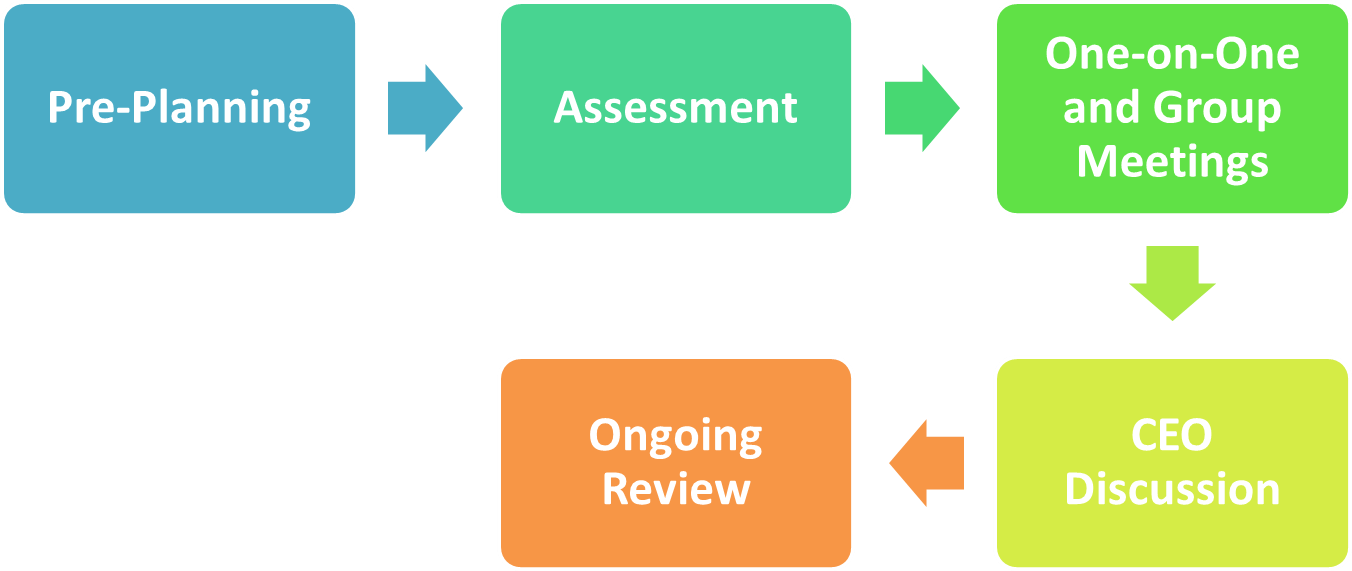The process of Succession Planning includes various steps as shown below in Figure 1,

Figure 1: Process of Succession Planning.
1) Pre-Planning: It is done by HR department managers in order to train such employees who have high level of potentiality, but are unable to utilize it in the right direction. This potentiality forms the basis for their selection to a high-level position that may become vacant in the future. It is a step-by-step process from the designing of the plan to its implementation. It includes informing the selected employees about the key roles they need to play in development of leadership and their accountability towards the organization Some managers avoid performing this task as they feel that they will be deprived of promotional opportunities, but they should understand that by identifying and developing good leaders, they provide benefit to the organization, which in turn rewards them for perfòrming their tasks effectively.
2) Assessment: The management should identify the suitable future leaders of the organization on the basis of their performance and potentiality considering the established leadership competencies. Rating and profiling are two ways by which managers develop a framework of performance and potential of an employee. Managers are required to maintain an employee profile that includes the entire career history of the employee, functions performed by him, his strengths, and his developmental needs. Further, managers are also required to develop a rating system to assess the potential of an employee. Finally, the best development programmes are conducted to improve the potential of the employee.
3) One-on-One and Group Meetings: The best way to identify the high potential of the organization and its developmental methods is one on one discussion, i.e., collecting information from variety of people of the organization. This method reduces any kind of biasness, as it is carried out between the HR personnel and the leaders of the organization. A person who is conducting this discussion not only reviews the potential profile and performance grid of the future leader but also prepares a replacement chart showing the vacant position, suitable employee and his current preparations for becoming future leader. Group session by organizational leaders is also a good way of reviewing the potential employees of the company. Discussing their findings with higher authorities can prove to be more beneficial. It not only helps in finding whether the employee selected for future vacancies is most appropriate or not, but also fills up any kind of gaps or issues that exist among the employees and higher authorities.
4) CEO Discussion: Regular discussions must take place between the business leaders and CEO on the high potential of the organization and the ways to develop their potential, so that they can be utilized in the future effectively. CEO must ensure that the needed resources such as time and money are available whenever required.
5) Ongoing Review: Succession planning is a continuous process that does not end even, if a pool of future leaders are selected and developed. Every time a higher position gets vacant, a new employee is given an opportunity to show his potential. Thus, it is the responsibility of the organization to identify the talent of various employees and retain those employees, who are capable of performing the role of future leaders and develop their skills accordingly. Any lacking on the part of an organization can deprive it of potential employees who can perform the role of future leaders effectively. Just because, their talent is not recognized appropriately in their organization but somewhere else, they may move towards better opportunities. Besides this, replacement charts should be updated and reassessment of succession planning should be done on either quarterly or semi-annual or annual basis.
